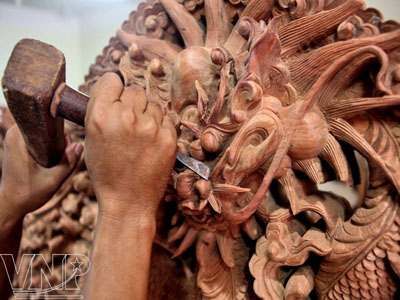Phu Khe Dragon carving village
VGP – Curious about the saying “Ha Noi is famous for the craft of embroidering fans and flags while Phu Khe is famous for carving king altars,” we visited the cradle of the craft of carving dragon patterns on wood in Phu Khe Commune, Tu Son District, Bac Ninh Province.
|
|
|
Photo: VNP |
Phu Khe is known as the land with the traditional craft of carving wood in the imperial citadel of Thang Long (present day Ha Noi).
In the past, the villagers specialized in making products used in the palaces of kings and lords.
The village’s craft vigorously developed during the Ly Dynasty and the village’s artisans left their imprints on many valuable architectural works in North Viet Nam such as But Thap Pagoda, Lim Pagoda, Tay Phuong Pagada, Tay Phuong Pagoda, Diem Xa Communal House, Dinh Bang Communal House and Ngoc Son Temple.
At present, the communal house of Phu Khe Village still preserves many ordinances of kings recognizing the locals’ merit in building royal palaces and tombs.
There were times the traditional craft seemed to get lost, however, thanks to joint effort of the locals, the craft has revived and strongly developed. When speaking about those who have contributed to the thriving of the village’s traditional craft, it is impossible not to mention artisan Nguyen Kim in Phu Khe Thuong Village who has spent years collecting and compiling documents and organizing training courses to bequeath the craft to over 300 young people.
Visiting the villages in Phu Khe Commune, we saw a bustling working atmosphere in workshops. According to Nguyen Thanh Hung, the head of Phu Khe Thuong Village, most of the families engage in the craft and many of them have become well-off. At present, the commune has seven enterprises and more than 70 workshops which bring high economic benefits, accounting for over 80% of the commune’s total production value.
The craft provides stable jobs for not only the villagers but also those from neighboring provinces. On average, a workshop has at least 10-15 employees, each earning about VND 4-5 million/month.
Each year, the commune’s villages produce thousands of sets of chairs and tables, wardrobes, trestles and wall paintings with delicate carved dragon patterns which are the favorite in the market.
Sharing with us about the craft’s secret, Nguyen Ngoc Khoa, son of artisan Nguyen Kim in Phu Khe said “Making products with dragon patterns required careful planning. The most difficult job is to make all the parts of the dragon look lively while the overall style and shape of the dragon remains strong and stark. The selection of wood for such artwork is also very important as we do not want viewers to notice differences in colors between different parts of carved wood products.”
Although many steps in production have been replaced by machines, however, the important ones must be done manually. Vo Toan, owner of Manh Cuong Fine Art Production Workshop said “Many customers like dragon carved tables, chairs and wall painting even if each set costs from VND 50-500 million and some others even reach VND 500 million to VND 1 billion.
Besides investment in facilities, the villagers in Phu Khe have paid much attention to improving designs, increasing product quality and applying new technology production. Therefore, their products have affirmed their position in the market. The dragon patterns on wooden products not only show the talent of Phu Khe artisans but also the prosperity of this rural area./.
VNP


